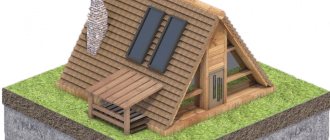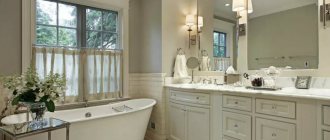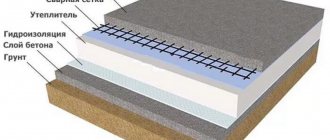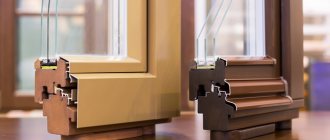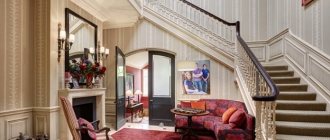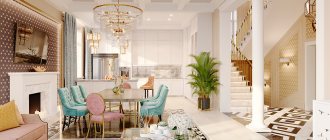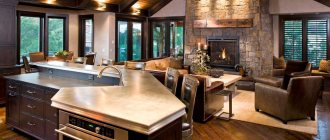French windows are not uncommon in modern homes.
Such windows have been used for about two hundred years, and for the first time this type of glazing appeared in France, and more precisely, in the southern regions of this wonderful country. French windows appeared in Russia at the beginning of the nineteenth century. French windows are large glazed frames and were used to decorate the windows of palaces and ancient country villas.
So why such windows have become in demand today, what their main feature is and what types of glazing exist, we will explain further.
Heating systems as an interior element
Each model line of heating equipment has a segment where radiators of small height are presented. This group includes products in which this parameter does not exceed 450 millimeters. A low heating radiator under a window is indispensable for heating constantly wet and cold walls facing the street along their entire length.
Such devices are used in the following cases:
- the presence of large panoramic windows;
- location of the heat supply system in the baseboards.
When choosing heating equipment, you need to take into account a number of technical parameters of the products:
- material of manufacture;
- dimensions;
- power;
- resistance to corrosion processes;
- scope, etc.
Horizontal radiators made of aluminum
The lowest aluminum heating radiators for panoramic windows have a height of 24.5 centimeters.
Similar models are produced by foreign companies:
- Sira. The company produces miniature radiators with heat output ranging from 89 to 97 W (products Rovall 80, Rovall 100, Swing, Alux 80 and Alux 100).
- Global. We offer a low cast radiator Gl-200/80/D, which is designed for installation in a heating system with an operating pressure of up to 16 Bar.
In this segment of domestic heating equipment, the most popular radiators are Rifar Base 200 and Rifar Forza 200. The number 200 indicates that their center distance is 20 centimeters.
Low horizontal heating devices made of aluminum have a number of important advantages:
- light weight - installation does not require the help of a team of builders;
- high degree of heat transfer;
- when the control valve is turned, the battery quickly responds to changes in operating environment parameters;
- A small volume of water is required to completely fill the system.
Of the negative characteristics of aluminum batteries, it should be noted:
- the chemical activity inherent in a given metal, which affects the quality of the water used;
- the softness of the manufacturing material, so the product is easily deformed.
The disadvantages of aluminum heating devices can be overcome if thorough water treatment is carried out before using them, which is recommended by the manufacturer’s instructions.
Manufacturers of aluminum radiators do not recommend using them in heat supply systems of multi-apartment buildings, where the quality of hot water is highly questionable.
If you plan to install an aluminum battery under panoramic windows, you should not forget that this metal has poor contact with copper and alloys that contain copper. Galvanized fittings function without problems with aluminum. You can also install wall-mounted electric heating radiators; they are also quite effective.
Features of installing heating radiators for different types of window structures
Correct installation of the heating radiator depends on the type and design of the windows. For window units of different designs, batteries are used, the dimensions of which correspond to the dimensions of the space underneath them.
Based on this, we can distinguish several main options for how to place a convector under a window:
- Standard placement relative to the battery window.
- Installation of convectors near the walls in balcony blocks with a doorway.
- Flat plate convectors for panoramic windows.
- Convector in the floor under the stained glass window.
- Hidden installation of a radiator under the window sill.
- Floor batteries under the panoramic block.
Most of these methods are not clearly regulated in SNiP, so in order to hang a heating radiator correctly, it is necessary to take into account the recommendations of manufacturers and builders.
Standard battery placement
The correct location relative to the battery window is determined by building codes. However, professionals recommend hanging the radiator so that it protrudes beyond the window sill by ¼ of its width. This will create the most effective thermal shield around the window.
In addition, it is recommended to choose a convector for a large window opening with internal fins so that the convection process is maximized.
In balcony blocks
It is recommended to install the convector under the double-glazed window of the balcony block across the entire width of the window sill. It is recommended to place the edge of the battery facing the unit door at a distance of 3-4 cm from it. It is not recommended to install shut-off valves or temperature controllers in this location. For installation, a device is selected whose power is 10-15% greater than the calculated one for this room.
Special convectors for panoramic windows
Heating radiators for panoramic windows are selected based on the size of the space under the window. It often happens that a panoramic window starts at floor level, without a window sill. In this case, it is recommended to install the battery near the window in a floor-standing version. If the floor arrangement of the radiator does not fit into the interior concept, you can install a convector under the floor, covering it with a decorative grille.
Convector in the floor under the stained glass windows
Stained glass windows have recently become increasingly popular not only for decorating staircases and winter gardens, but also work offices and living rooms. And if there is such a window in the room, then it is recommended to install radiators for stained glass windows so that they do not distract attention and fit harmoniously into the interior. The specificity of installing such devices is to ensure the direction of warm air onto the stained glass window as efficiently as possible.
Bimetallic devices for panoramic windows
This type of radiator belongs to heat supply equipment, the high cost of which best corresponds to the quality.
Bimetallic radiators differ:
- High working pressure.
- Compatible with other metals. In them, aluminum is used only for the manufacture of the shell, which increases the aesthetics of appearance and heat transfer. As for the internal casing, equipped with outlets for connection to the system, it is made of stainless steel or black steel.
According to experts, bimetallic radiators are the best option for systems connected to a centralized heating supply. Their use for supplying heat to private households is unjustified in terms of safety margins and monetary costs.
The height of bimetallic radiators for panoramic windows ranges from 24.5 to 45 centimeters.
Features of application
Most often, such structures are installed by owners of private houses, using them in any room (kitchen, living room, bedroom, instead of the main exit, and so on). But due to their rich appearance, such systems are often used by apartment owners, installing them, as a rule, instead of a balcony block or between a loggia and a room. But then you will have to partially or completely destroy the wall, which must be load-bearing. We will talk about options for installing structural structures a little later.
Steel low batteries
When it is necessary to equip a very low heating system with a height of 100, 150 or 180 millimeters, tubular steel radiators can be installed. These products are made rectilinear and in the form of structures of unusual shapes, repeating the configuration of the space under the window.
Tubular heating devices function quite well in different systems, regardless of the method of circulation of the working environment - forced or natural. There are also thin heating radiators that take up little space.
Models without housing
In this case, heating radiators are installed in a specially prepared niche. Its walls are insulated. The most commonly used is polyester foam. Batteries of this type are mainly located in new buildings, where their installation is provided for in the design documentation.
Diagram and principle of operation of a liquid electric radiator
The heating circuit is installed inside the niche at a height of 10 cm from the bottom. This is due to fire safety regulations. Also, the presence of an air gap improves the movement of warm masses and increases the efficiency of the heating device.
The channel with heating elements is closed with a special grille. It must withstand significant loads that are possible during operation.
Also, the grill must be removable so that the channel can be cleaned of accumulated dust. It can move completely away or collapse.
Heating in baseboards
Relatively recently, a new and lowest method of creating heating has appeared. In this case, the heat supply structure consists of copper tubes finned with plates, due to which heat transfer increases. Water circulates through them.
The tubes are laid around the perimeter of the room and covered with special metal baseboards. This heating design has the smallest dimensions. It is 30 millimeters wide and has a height of 100–200 millimeters (depending on the power of the system).
Heating in baseboards has the following advantages:
- Great opportunities for implementing design solutions in the interior.
- Uniform distribution of warm flows along the walls.
When a unique design is created in a room, it is low radiators for stained glass windows that allow the heating system to be correctly and beautifully integrated into the interior.
Decor
One of the main advantages of the design is that such a structure itself serves as a decoration for any building without any additional decorative elements. For decorative purposes, such blocks can be tinted, curtained with light, translucent fabric or roller blinds, decorated with stained glass or sliding screens. Pleated blinds or classic roller blinds look good on voluminous window structures.
The choice of design option depends, as a rule, on the design of the room and, of course, on the preferences of the owners of the house. So, for example, a room whose interior is dominated by light, light colors is curtained with the same light, translucent, almost weightless fabric (organza is often used). Or, on the contrary, they can use curtains of a completely different shade to focus attention on this element.
Note. When decorating, it is not recommended to use heavy, very dense fabrics. The main rule that should be followed when choosing decor for a panoramic design is to emphasize the elegance and presentable appearance.
Problems with large windows - why do they occur?
A French window is, by and large, a glass wall. Its main advantage - a large glazing area - from the point of view of heating engineering becomes a disadvantage. This is why such windows often “cry”: at the slightest drop in temperature, condensation forms on the inner surface of the glass, which flows down and can form large puddles.
And the point is not that you bought low-quality windows - you just can’t argue with physics:
- The thermal conductivity of the window (even if you have chosen an energy-saving double-glazed window) will in any case be higher than that of the walls surrounding it. Thus, the glass becomes the coldest area in the room, and it is on it that moisture from the air will condense.
- Warm air rises and cold air sinks. This is why the lower part of the window, adjacent to the floor, will suffer: it is in this zone that the temperature will be the lowest. So freezing will start from here.
In the case of ordinary windows, the problem is solved by heating with radiators installed under the window sills. They already do a good job, but if you cut a special grill into the window sill board, condensation, if it appears, will only last for a few minutes.
This solution is not suitable for French windows: they do not have a window sill as such, and placing the radiator in front of the glass means significantly worsening the appearance of the entire structure. That is why to solve the problem of condensation and freezing you need to use special heating devices.
Do-it-yourself insulation of a French balcony
A modern apartment is a multifunctional room in which they strive to create the utmost comfort. The appearance of French windows gave owners the chance to visually expand the premises, “push apart” the walls and go far beyond its boundaries.
Window insulation
You need to start taking care of comfort and warmth in your own home even before installing a French balcony. Installing a multi-layer window structure that will prevent winter air from penetrating inside will help make your apartment warm. If you live in a locality with a moderately warm climate, it is enough to install energy-saving glass with triple glazing. In this case, special attention must be paid to the profile design. It is important that it reliably protects against heat loss.
Internal insulation of floor and ceiling
When the work on glazing the balcony is completed, you should move on to insulating the ceiling and floor. Before this, it is recommended to waterproof the entire area of the room. Please note that the insulation layer should not be excessively large. The thickness will be enough for you, which in combination with the finishing material will not exceed the height of the window profile.
Using built-in convectors for heating
Features of the use of in-floor heaters
To prevent the glass inside from becoming covered with condensation and freezing, it must be effectively heated. In the case of floor-to-ceiling glazing, a design such as a built-in convector will help:
- Convectors of this type are located in niches inside the floor. Warm air from their heat exchange elements rises, entering the room through a protective and decorative grille.
- By placing the convector along the French window, we will ensure that the flow of warm air hits the glass directly. Thanks to this, the temperature of the glass will increase and condensation will not fall out.
And even if it does, the flow of warm air will effectively dry the surface, so you shouldn’t be afraid of drops, and especially puddles on the floor. The same applies to the ice crust along the lower edge of the glazing.
- In addition, heating a window using an in-floor convector solves another problem. The cold zone that forms near the glass disappears in the room, so when we approach the glass, we are guaranteed not to experience any unpleasant sensations.
Technical component
Anyone who is thinking about panoramic glazing at home is concerned about the choice of double-glazed windows. The price of the issue and the appearance of the windows depend on their variety. In addition, both the installation method and the formula are important.
Frames
There is also a frameless option, but it is usually used for loggias, where the size of the glass allows you to do without a rigid frame, just with guides. For glazing houses, the following variations are more in demand:
- PVC is a budget option, but has dimensional limitations.
- Wood - laminated veneer lumber, otherwise - LVL beams.
- Aluminum is strong, durable, lightweight, expensive. The most reliable version of the panorama, designed for massive windows. He is recommended by both manufacturers and the majority of users, among them Rexther; he specializes in glazing and, as an experienced craftsman, knows what is best.
Installation method
In private construction, two main methods are used.
- ODS: window-door system. Internal glazing and stained glass windows are enclosed in frames; in fact, these are huge windows mounted to the ceilings.
- Structural glazing (facade) - there is no protruding frame from the outside, the mullion-transom sheathing remains inside, and the glass is mounted with a special glue, the joints are sealed with sealant.
Both methods allow you to make both monolithic panoramic windows and sliding ones, and combine glazing with doorways. The monolith is easier to install and costs less, but the opportunity to open access to air in the warm season and not bother with additional ventilation will pay for everything.
Advantages of convector systems
Recently, built-in convectors, such as VARMANN Qtherm Q EM and its analogues, have gained considerable popularity. The main reason for this development of events is that such products have a solid list of advantages:
- Efficient heating. A large number of heat exchange elements allows energy to be transferred from the coolant with minimal losses. Where an old radiator heats its walls, a convector heats the air!
- Compact sizes. This advantage follows directly from the previous one: an efficient device does not have to be large in order to produce a large amount of heat. The total area of the heat exchange plates of even a small convector is greater than the surface area of a cast iron battery with a dozen fins.
- Optimal heat distribution. Located deep in the floor, the convector heats primarily the lower, coldest layer of air. This means that the situation “your head is hot and your feet are cold” in a room heated by convectors will be impossible.
- Possibility of installation along windows. This advantage is the most relevant for owners of “French” glazing. There is practically no alternative to built-in convectors here: we either install the heating device in the thickness of the floor, or we tolerate condensation and freezing in winter.
How effective the built-in convector will be, and how pronounced the effect of its installation will be, depends on the correct selection of equipment. Here you should consult with specialists by contacting them by phone. You will be provided with all the necessary information on the selection of heating equipment, in addition, you will be able to make a purchase over the phone, as well as place an order for the delivery and installation of a convector.
Adviсe
As can be concluded from reviews on the Internet, the popularity of French window designs sometimes pushes our citizens to the idea of installing them where the French themselves would never have thought of. It must be remembered that when installing such windows, their functionality and economic feasibility are important.
In a small city apartment with a balcony, such windows are unlikely to be appropriate. In addition, such redevelopment is not always safe, because windows are installed in facade walls, which are load-bearing. Do not carry out alterations yourself, especially dismantling walls in residential buildings, without coordinating the project with the relevant structures.
You can learn about the pros and cons of a French balcony from the following video.
If you are building a private house from scratch, then it will be much easier for you to add French windows to the project. And at the remodeling stage, contact an architect who will take into account the features of the building and draw up a plan for installing panoramic windows. As a rule, powerful lintels or columns are used to support the second floor.
If you live on a high floor, consider the “psychological moment” in advance . For some people at altitude, such a window can act like a “portal to the abyss” and become a phobia. French glazing is not very favorable at heights and where there are children. Firstly, it is unsafe, and secondly, get ready to see and clean traces of children's palms several times a day.
Such a pressing problem of French windows as condensation can be solved by ensuring good supply and exhaust ventilation in the room.
If the frames are made of wood, they may be scratched. In this case, the surface can be restored by puttying and polishing.
When choosing windows, pay attention to the presence of pressure rollers at the bottom and top. If the sash is secured only with a central lock, its edges will move away from the insulation, increasing heat loss. The sash must have a transom mode, which will allow the room to be ventilated.
If you want to make a French window original and exclusive, use a decorative layout (shprosy), which is a plastic or aluminum grille inserted into the window, dividing the glass into several blocks.
Such decorative elements not only serve the aesthetic function of decorating a window, but are also intended to strengthen a large glazing area. The layouts can be constructive (the frames divide the window frame into several fragments, in each of which a double-glazed window is inserted), Venetian, which are glued to the glass inside or outside, and interglazed, planned between the glasses during the manufacture of the double-glazed window. Such sprats are the most practical and easy to care for.
If during operation the door adjustment is disrupted and jamming appears, adjust the elements yourself or with the help of specialists. It is enough to carefully study the instructions, which describe the purpose and function of all bolts.
Do not repair “at random”, because this can easily damage or break the mechanism . And before adjusting, open the door, first placing a wedge under it so that the heavy structure does not fall and you can hold it.
How to choose a radiator with panoramic glazing
Panoramic glazing allows you to enjoy a magnificent view, admire the sunrise, snowfall, and spring rain. Window openings that reach almost to the floor can be installed both in a private house and in an apartment building - the view from the upper floors is especially beautiful.
When planning the installation of a panoramic window, remember that in winter you cannot do without radiators. The traditional arrangement of heating devices under a window sill with panoramic glazing is impossible. Therefore, it is worth looking for other options.
What it is?
This is a window module with a height from ceiling to floor. But, in addition to this function, it is also endowed with the functionality of a door. Such window systems visually expand the room, make the room lighter and more spacious, and provide a full view. In addition, they have a very attractive appearance.
As mentioned above, such designs are often called panoramic, but this is not entirely correct, since they differ from the so-called “foreign” ones by the absence of a doorway.
Heat from the floor - pros and cons
Built-in convectors are convenient because they:
- completely hidden in the floor, so you don’t need to think about how to fit them into the interior;
- They have high power and quickly warm up the air in the room.
But for many, the disadvantages of convectors significantly outweigh their advantages:
- high cost of the devices themselves and installation work;
- the impossibility of installing efficient models with a height of 80 mm or more with a low floor screed;
- noisy operation of fans in powerful models;
- Heating based on the convection principle leads to dry air, which is fraught with health problems.
Low Batteries: Pros and Cons
Low models are good because they can be installed under a window sill, which rises from the floor by a few centimeters. At the same time, the panoramic view will be preserved, and the problem of heating the room will be solved.
Low models of Irsap radiators in interior design Low models of Irsap radiators in interior design Low models of Irsap radiators in interior design
The main advantages of low tubular radiators are:
- low price;
- high heat transfer;
- ease of installation;
- large selection - you can choose the number of sections, width, depth of the device, tube diameter, color.
There are few disadvantages to this solution; they boil down to the fact that budget options, as a rule, have a rather primitive design, and beautiful designer models are not very cheap.
Design
A French balcony is a design that can be decorated in any, most incredible way. Modern designers are sophisticated and come up with the most elaborate variations that will turn an ordinary room into a work of art where you will want to spend all your time, or into a modernized room. It is first necessary to draw up a plan, on the basis of which the masters will work.
A French balcony can be decorated both outside and inside. First of all, you need to think about insulation and only then take care of the decor. The use of various curtains, flower pots and various finishing variations is allowed.
Another great solution is wrought-iron balconies. They are ideal for small apartments that suffer from a lack of light and solar heat. Forged products have a variety of shapes, so there will be a large selection.
Why vertical tubular radiators are better
A universal solution is a vertical radiator. These are tall devices that are installed not under the window sill, but next to the window opening.
- have an original appearance, look stylish, non-standard;
- have high productivity due to the large working surface area;
- do not block the view from the window.
Vertical radiators Irsap in the interior design of a room Vertical radiators Irsap in the interior design of a room Vertical radiators Irsap in the interior design of a room
Conclusion: which batteries to choose?
For a small room or a room with a long window, choose low radiators. If space allows, a universal solution is vertical steel tubes. They are the most practical, easy to use, and beautiful.
If your budget is above average, explore designer lines: manufacturers such as the Italian brand IRSAP offer a lot of non-standard options. The battery can become an unusual decorative element that will add zest to the interior.
Source: “How to choose a radiator with panoramic glazing”
